Comprehensive Report: Office Management, Health, Safety, and Meetings
VerifiedAdded on 2020/06/04
|12
|2807
|128
Report
AI Summary
This report provides a comprehensive analysis of office administration, encompassing facility management, health and safety protocols, and effective meeting procedures. It delves into legal requirements for managing office facilities, including health and safety obligations, accident and emergency procedures, and the responsibilities of employers and individuals. The report examines the purpose, legal implications, and accuracy of meeting minutes, along with techniques for note-taking and facilitating meetings. It further explores managing office resources, monitoring workflows, and providing support and welfare facilities. The report also covers allocating work, quality management techniques, and identifying areas for improvement in team performance. Finally, it outlines the characteristics, planning, and resource management aspects of different types of events. The report emphasizes the importance of efficiency, productivity, and employee satisfaction in a well-managed office environment.
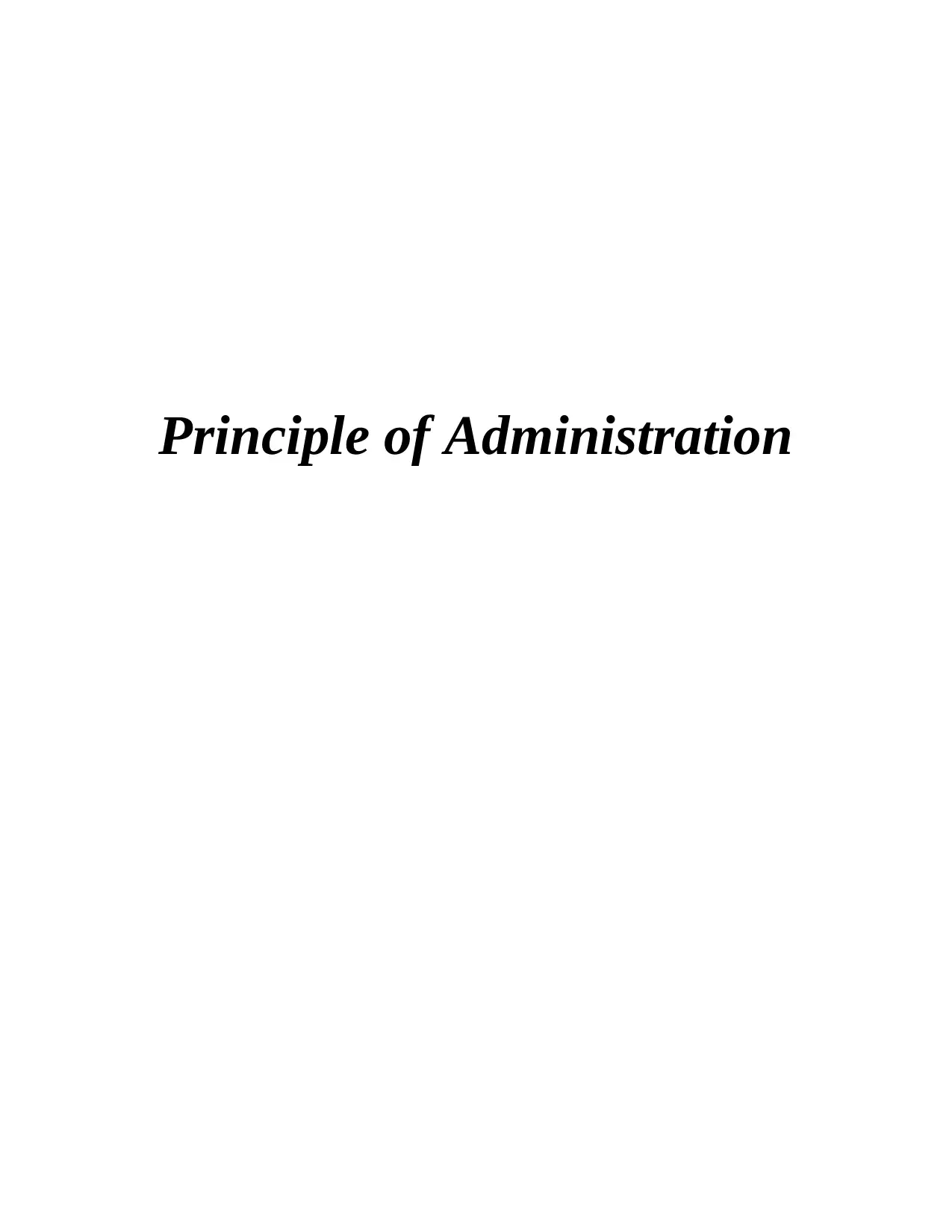
Principle of Administration
Paraphrase This Document
Need a fresh take? Get an instant paraphrase of this document with our AI Paraphraser
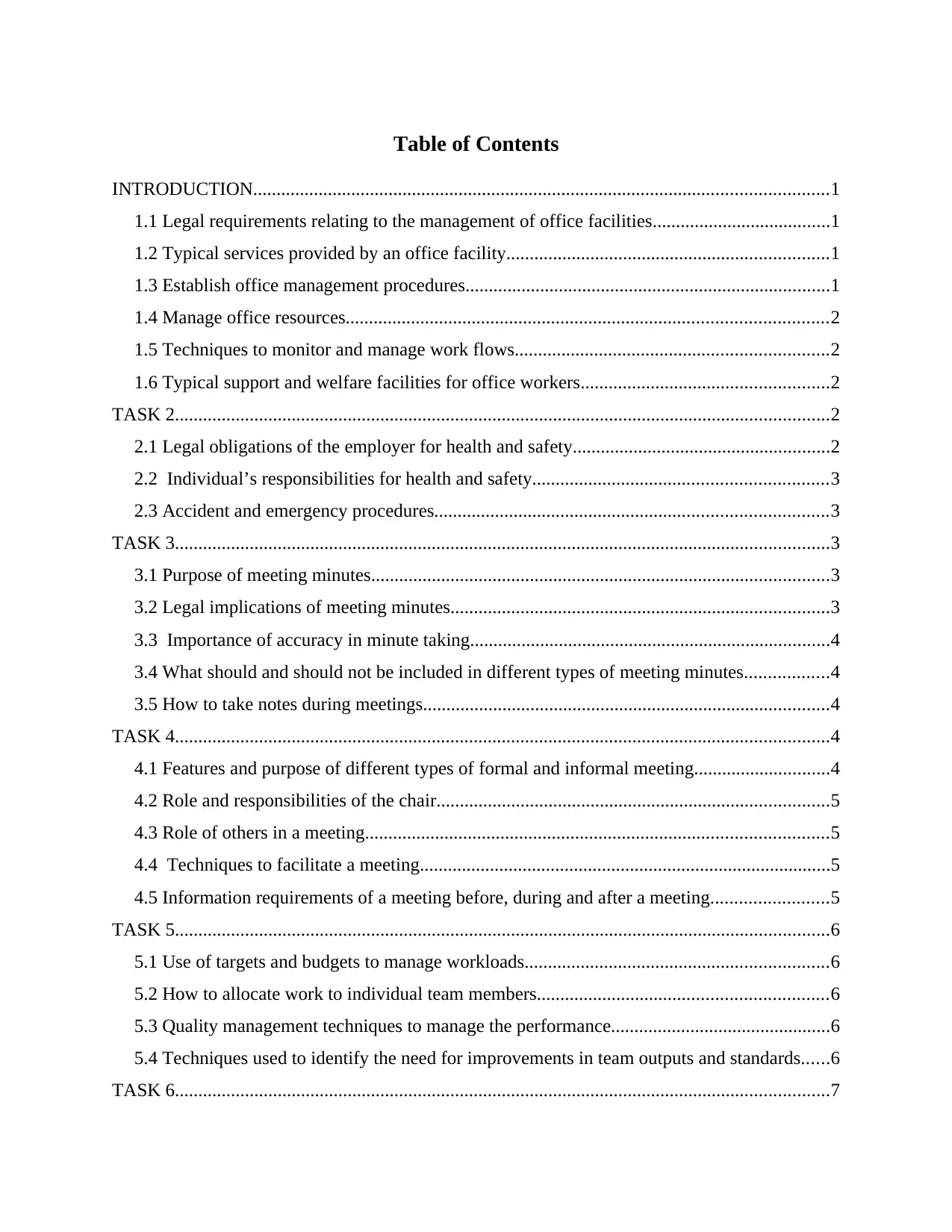
Table of Contents
INTRODUCTION...........................................................................................................................1
1.1 Legal requirements relating to the management of office facilities......................................1
1.2 Typical services provided by an office facility.....................................................................1
1.3 Establish office management procedures..............................................................................1
1.4 Manage office resources.......................................................................................................2
1.5 Techniques to monitor and manage work flows...................................................................2
1.6 Typical support and welfare facilities for office workers.....................................................2
TASK 2............................................................................................................................................2
2.1 Legal obligations of the employer for health and safety.......................................................2
2.2 Individual’s responsibilities for health and safety...............................................................3
2.3 Accident and emergency procedures....................................................................................3
TASK 3............................................................................................................................................3
3.1 Purpose of meeting minutes..................................................................................................3
3.2 Legal implications of meeting minutes.................................................................................3
3.3 Importance of accuracy in minute taking.............................................................................4
3.4 What should and should not be included in different types of meeting minutes..................4
3.5 How to take notes during meetings.......................................................................................4
TASK 4............................................................................................................................................4
4.1 Features and purpose of different types of formal and informal meeting.............................4
4.2 Role and responsibilities of the chair....................................................................................5
4.3 Role of others in a meeting...................................................................................................5
4.4 Techniques to facilitate a meeting........................................................................................5
4.5 Information requirements of a meeting before, during and after a meeting.........................5
TASK 5............................................................................................................................................6
5.1 Use of targets and budgets to manage workloads.................................................................6
5.2 How to allocate work to individual team members..............................................................6
5.3 Quality management techniques to manage the performance...............................................6
5.4 Techniques used to identify the need for improvements in team outputs and standards......6
TASK 6............................................................................................................................................7
INTRODUCTION...........................................................................................................................1
1.1 Legal requirements relating to the management of office facilities......................................1
1.2 Typical services provided by an office facility.....................................................................1
1.3 Establish office management procedures..............................................................................1
1.4 Manage office resources.......................................................................................................2
1.5 Techniques to monitor and manage work flows...................................................................2
1.6 Typical support and welfare facilities for office workers.....................................................2
TASK 2............................................................................................................................................2
2.1 Legal obligations of the employer for health and safety.......................................................2
2.2 Individual’s responsibilities for health and safety...............................................................3
2.3 Accident and emergency procedures....................................................................................3
TASK 3............................................................................................................................................3
3.1 Purpose of meeting minutes..................................................................................................3
3.2 Legal implications of meeting minutes.................................................................................3
3.3 Importance of accuracy in minute taking.............................................................................4
3.4 What should and should not be included in different types of meeting minutes..................4
3.5 How to take notes during meetings.......................................................................................4
TASK 4............................................................................................................................................4
4.1 Features and purpose of different types of formal and informal meeting.............................4
4.2 Role and responsibilities of the chair....................................................................................5
4.3 Role of others in a meeting...................................................................................................5
4.4 Techniques to facilitate a meeting........................................................................................5
4.5 Information requirements of a meeting before, during and after a meeting.........................5
TASK 5............................................................................................................................................6
5.1 Use of targets and budgets to manage workloads.................................................................6
5.2 How to allocate work to individual team members..............................................................6
5.3 Quality management techniques to manage the performance...............................................6
5.4 Techniques used to identify the need for improvements in team outputs and standards......6
TASK 6............................................................................................................................................7
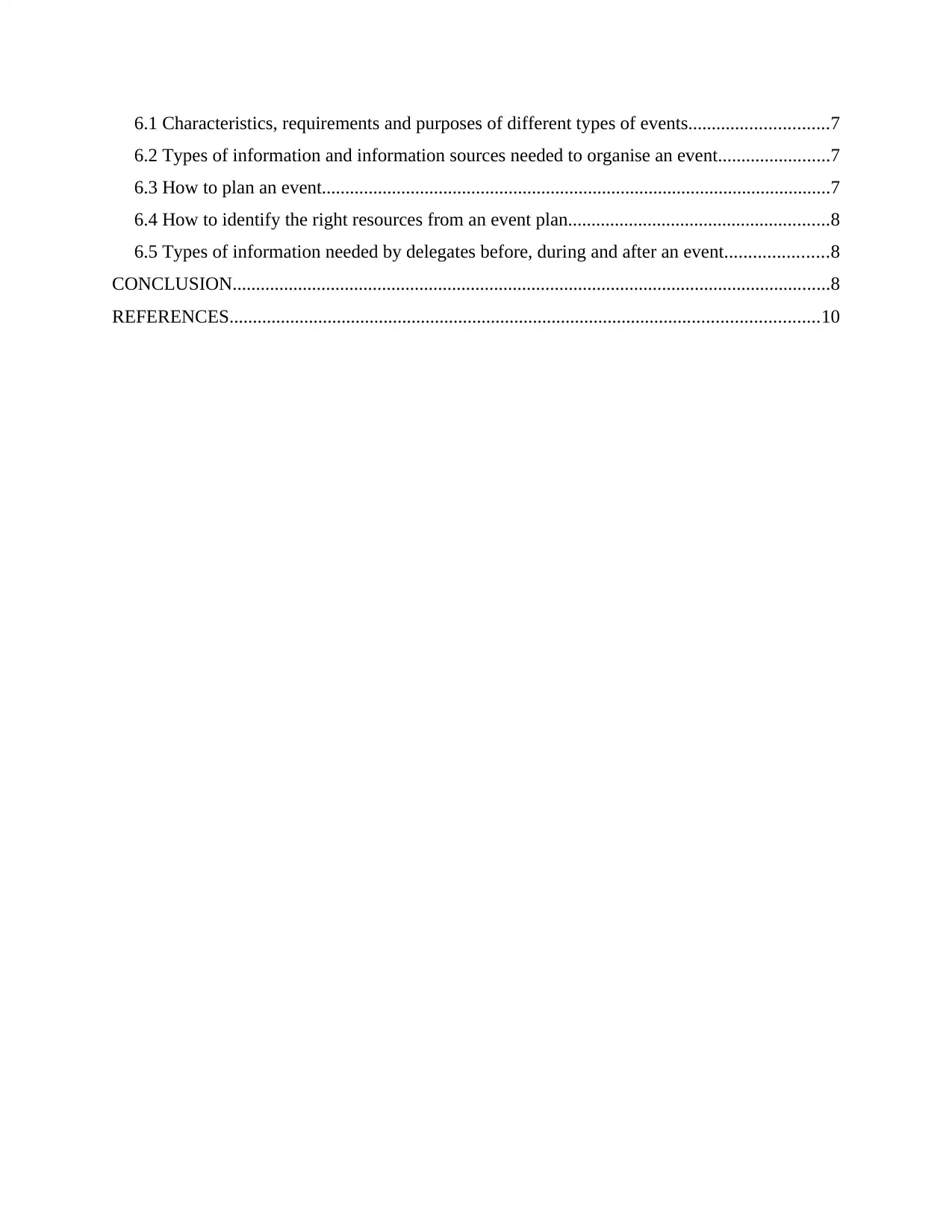
6.1 Characteristics, requirements and purposes of different types of events..............................7
6.2 Types of information and information sources needed to organise an event........................7
6.3 How to plan an event.............................................................................................................7
6.4 How to identify the right resources from an event plan........................................................8
6.5 Types of information needed by delegates before, during and after an event......................8
CONCLUSION................................................................................................................................8
REFERENCES..............................................................................................................................10
6.2 Types of information and information sources needed to organise an event........................7
6.3 How to plan an event.............................................................................................................7
6.4 How to identify the right resources from an event plan........................................................8
6.5 Types of information needed by delegates before, during and after an event......................8
CONCLUSION................................................................................................................................8
REFERENCES..............................................................................................................................10
⊘ This is a preview!⊘
Do you want full access?
Subscribe today to unlock all pages.

Trusted by 1+ million students worldwide
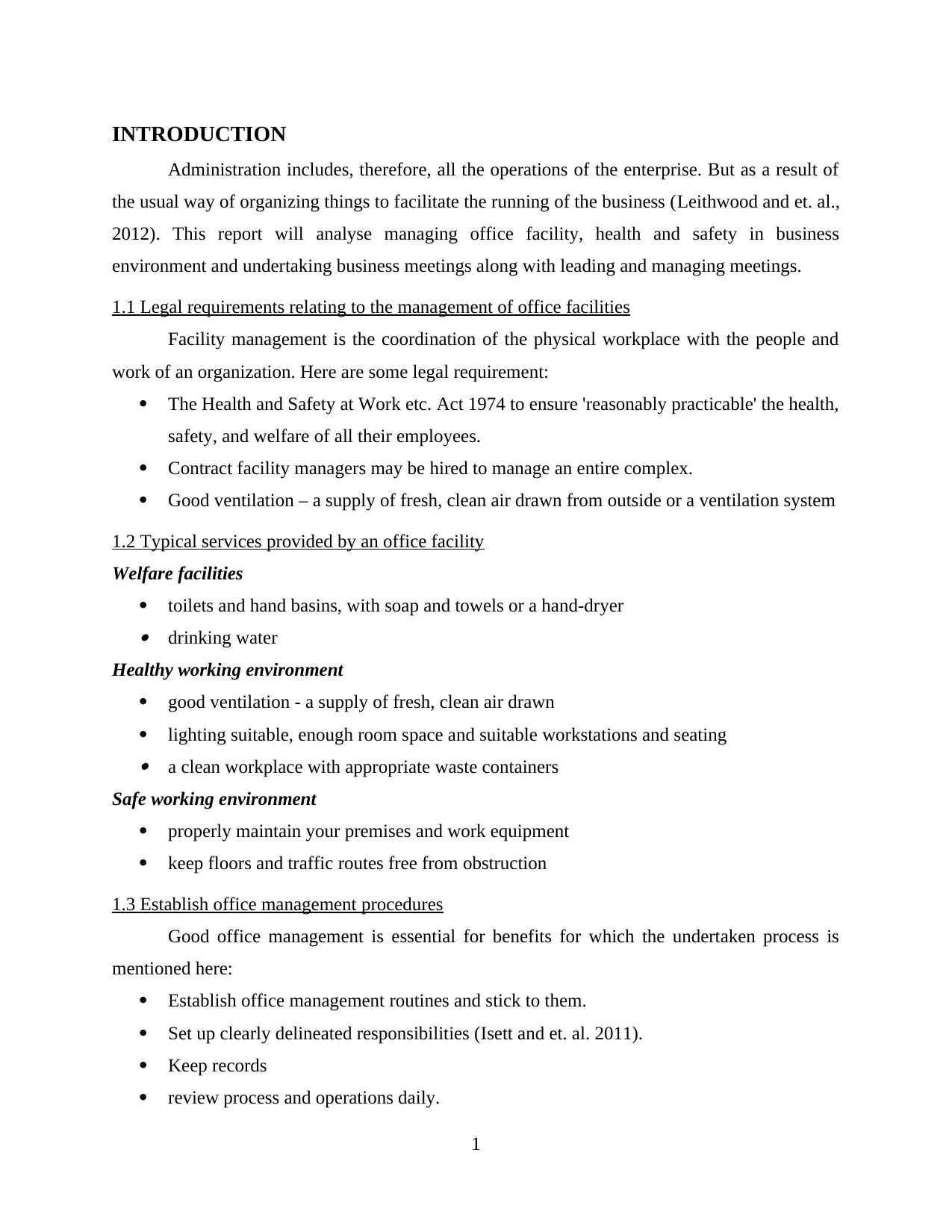
INTRODUCTION
Administration includes, therefore, all the operations of the enterprise. But as a result of
the usual way of organizing things to facilitate the running of the business (Leithwood and et. al.,
2012). This report will analyse managing office facility, health and safety in business
environment and undertaking business meetings along with leading and managing meetings.
1.1 Legal requirements relating to the management of office facilities
Facility management is the coordination of the physical workplace with the people and
work of an organization. Here are some legal requirement:
The Health and Safety at Work etc. Act 1974 to ensure 'reasonably practicable' the health,
safety, and welfare of all their employees.
Contract facility managers may be hired to manage an entire complex.
Good ventilation – a supply of fresh, clean air drawn from outside or a ventilation system
1.2 Typical services provided by an office facility
Welfare facilities
toilets and hand basins, with soap and towels or a hand-dryer drinking water
Healthy working environment
good ventilation - a supply of fresh, clean air drawn
lighting suitable, enough room space and suitable workstations and seating a clean workplace with appropriate waste containers
Safe working environment
properly maintain your premises and work equipment
keep floors and traffic routes free from obstruction
1.3 Establish office management procedures
Good office management is essential for benefits for which the undertaken process is
mentioned here:
Establish office management routines and stick to them.
Set up clearly delineated responsibilities (Isett and et. al. 2011).
Keep records
review process and operations daily.
1
Administration includes, therefore, all the operations of the enterprise. But as a result of
the usual way of organizing things to facilitate the running of the business (Leithwood and et. al.,
2012). This report will analyse managing office facility, health and safety in business
environment and undertaking business meetings along with leading and managing meetings.
1.1 Legal requirements relating to the management of office facilities
Facility management is the coordination of the physical workplace with the people and
work of an organization. Here are some legal requirement:
The Health and Safety at Work etc. Act 1974 to ensure 'reasonably practicable' the health,
safety, and welfare of all their employees.
Contract facility managers may be hired to manage an entire complex.
Good ventilation – a supply of fresh, clean air drawn from outside or a ventilation system
1.2 Typical services provided by an office facility
Welfare facilities
toilets and hand basins, with soap and towels or a hand-dryer drinking water
Healthy working environment
good ventilation - a supply of fresh, clean air drawn
lighting suitable, enough room space and suitable workstations and seating a clean workplace with appropriate waste containers
Safe working environment
properly maintain your premises and work equipment
keep floors and traffic routes free from obstruction
1.3 Establish office management procedures
Good office management is essential for benefits for which the undertaken process is
mentioned here:
Establish office management routines and stick to them.
Set up clearly delineated responsibilities (Isett and et. al. 2011).
Keep records
review process and operations daily.
1
Paraphrase This Document
Need a fresh take? Get an instant paraphrase of this document with our AI Paraphraser
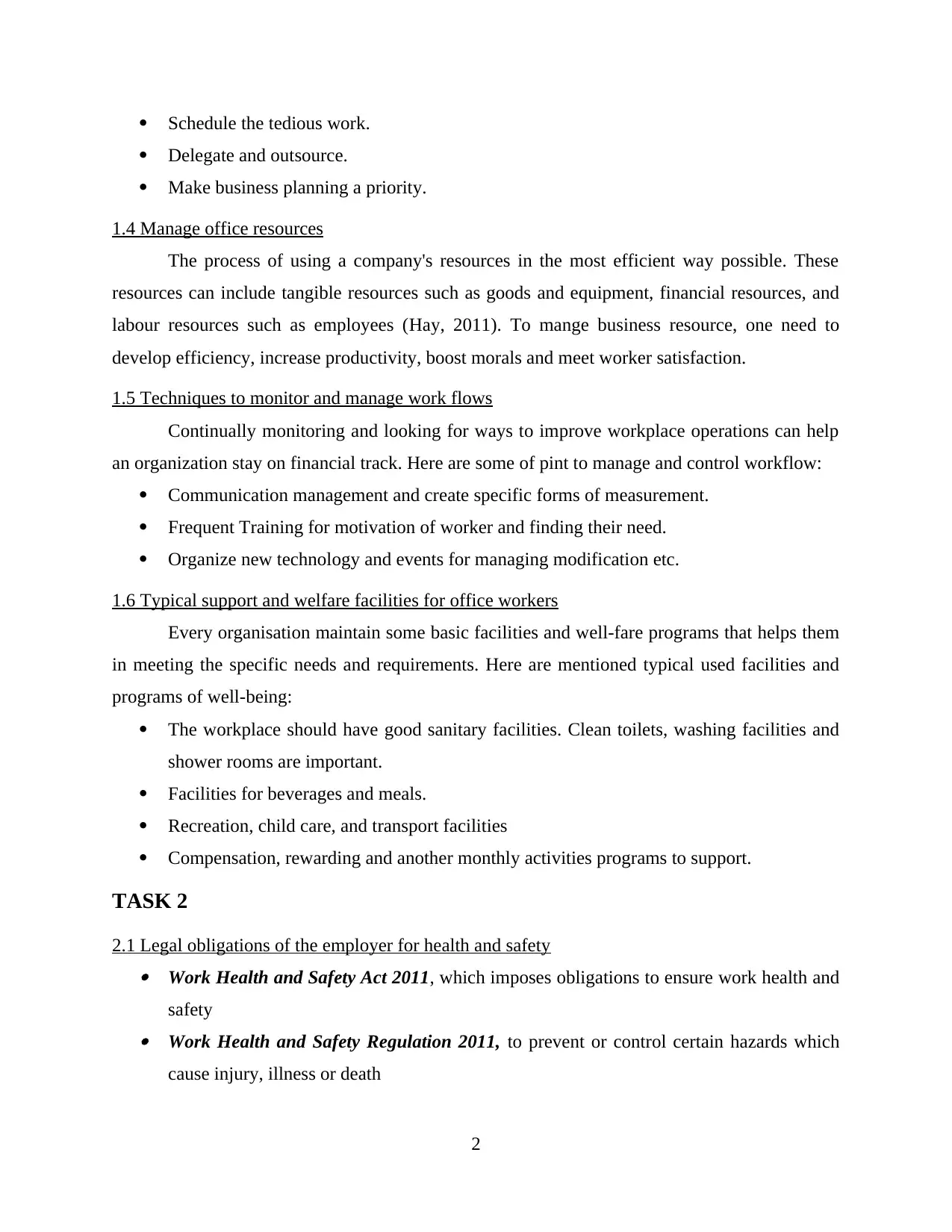
Schedule the tedious work.
Delegate and outsource.
Make business planning a priority.
1.4 Manage office resources
The process of using a company's resources in the most efficient way possible. These
resources can include tangible resources such as goods and equipment, financial resources, and
labour resources such as employees (Hay, 2011). To mange business resource, one need to
develop efficiency, increase productivity, boost morals and meet worker satisfaction.
1.5 Techniques to monitor and manage work flows
Continually monitoring and looking for ways to improve workplace operations can help
an organization stay on financial track. Here are some of pint to manage and control workflow:
Communication management and create specific forms of measurement.
Frequent Training for motivation of worker and finding their need.
Organize new technology and events for managing modification etc.
1.6 Typical support and welfare facilities for office workers
Every organisation maintain some basic facilities and well-fare programs that helps them
in meeting the specific needs and requirements. Here are mentioned typical used facilities and
programs of well-being:
The workplace should have good sanitary facilities. Clean toilets, washing facilities and
shower rooms are important.
Facilities for beverages and meals.
Recreation, child care, and transport facilities
Compensation, rewarding and another monthly activities programs to support.
TASK 2
2.1 Legal obligations of the employer for health and safety Work Health and Safety Act 2011, which imposes obligations to ensure work health and
safety Work Health and Safety Regulation 2011, to prevent or control certain hazards which
cause injury, illness or death
2
Delegate and outsource.
Make business planning a priority.
1.4 Manage office resources
The process of using a company's resources in the most efficient way possible. These
resources can include tangible resources such as goods and equipment, financial resources, and
labour resources such as employees (Hay, 2011). To mange business resource, one need to
develop efficiency, increase productivity, boost morals and meet worker satisfaction.
1.5 Techniques to monitor and manage work flows
Continually monitoring and looking for ways to improve workplace operations can help
an organization stay on financial track. Here are some of pint to manage and control workflow:
Communication management and create specific forms of measurement.
Frequent Training for motivation of worker and finding their need.
Organize new technology and events for managing modification etc.
1.6 Typical support and welfare facilities for office workers
Every organisation maintain some basic facilities and well-fare programs that helps them
in meeting the specific needs and requirements. Here are mentioned typical used facilities and
programs of well-being:
The workplace should have good sanitary facilities. Clean toilets, washing facilities and
shower rooms are important.
Facilities for beverages and meals.
Recreation, child care, and transport facilities
Compensation, rewarding and another monthly activities programs to support.
TASK 2
2.1 Legal obligations of the employer for health and safety Work Health and Safety Act 2011, which imposes obligations to ensure work health and
safety Work Health and Safety Regulation 2011, to prevent or control certain hazards which
cause injury, illness or death
2

work health and safety codes of practice, to give practical advice about ways to manage
exposure to risks (De Vries and Nemec, 2013).
2.2 Individual’s responsibilities for health and safety
Here are mentioned some:
to take reasonable care of your own health and safety.
if possible to avoid wearing jewellery or loose clothing if operating machinery
to take reasonable care not to put other people at risk.
to co-operate with employer, health and safety policies.
to report any injuries, strains or illnesses suffer while doing job etc.
2.3 Accident and emergency procedures
There are also requirements involving the health and safety of employees, these include;
making sure there is a good ventilation system with windows that can be opened and cleaned
safely, a reasonable working temperature, suitable lighting and a clean workplace.
It is not a legal requirement to provide a room for those who smoke as of July 2007,
smoking became banned in all enclosed areas. However it is completely optional for employers
to provide their employees with an outdoor area designed for smoking.
TASK 3
3.1 Purpose of meeting minutes
Meeting minutes are the official record of the actions and decisions taken in a meeting or
hearing (Caironi and et. al. 2014). The purpose of determining meeting minutes is delivering
legal structure and protection as well as delivering permanent recodes with authority and formal
evidence if expenditure an actions.
3.2 Legal implications of meeting minutes
Minutes should be an exact portrayal of the meeting’s agenda. Here is process of legal
execution:
1. Write or type a heading that indicates the topic.
2. State the time of meeting.
3. Write a note saying that the quorum was met.
4. Take notes on all discussions of business items.
5. Write "meeting adjourned" and give the time the meeting ended.
3
exposure to risks (De Vries and Nemec, 2013).
2.2 Individual’s responsibilities for health and safety
Here are mentioned some:
to take reasonable care of your own health and safety.
if possible to avoid wearing jewellery or loose clothing if operating machinery
to take reasonable care not to put other people at risk.
to co-operate with employer, health and safety policies.
to report any injuries, strains or illnesses suffer while doing job etc.
2.3 Accident and emergency procedures
There are also requirements involving the health and safety of employees, these include;
making sure there is a good ventilation system with windows that can be opened and cleaned
safely, a reasonable working temperature, suitable lighting and a clean workplace.
It is not a legal requirement to provide a room for those who smoke as of July 2007,
smoking became banned in all enclosed areas. However it is completely optional for employers
to provide their employees with an outdoor area designed for smoking.
TASK 3
3.1 Purpose of meeting minutes
Meeting minutes are the official record of the actions and decisions taken in a meeting or
hearing (Caironi and et. al. 2014). The purpose of determining meeting minutes is delivering
legal structure and protection as well as delivering permanent recodes with authority and formal
evidence if expenditure an actions.
3.2 Legal implications of meeting minutes
Minutes should be an exact portrayal of the meeting’s agenda. Here is process of legal
execution:
1. Write or type a heading that indicates the topic.
2. State the time of meeting.
3. Write a note saying that the quorum was met.
4. Take notes on all discussions of business items.
5. Write "meeting adjourned" and give the time the meeting ended.
3
⊘ This is a preview!⊘
Do you want full access?
Subscribe today to unlock all pages.

Trusted by 1+ million students worldwide
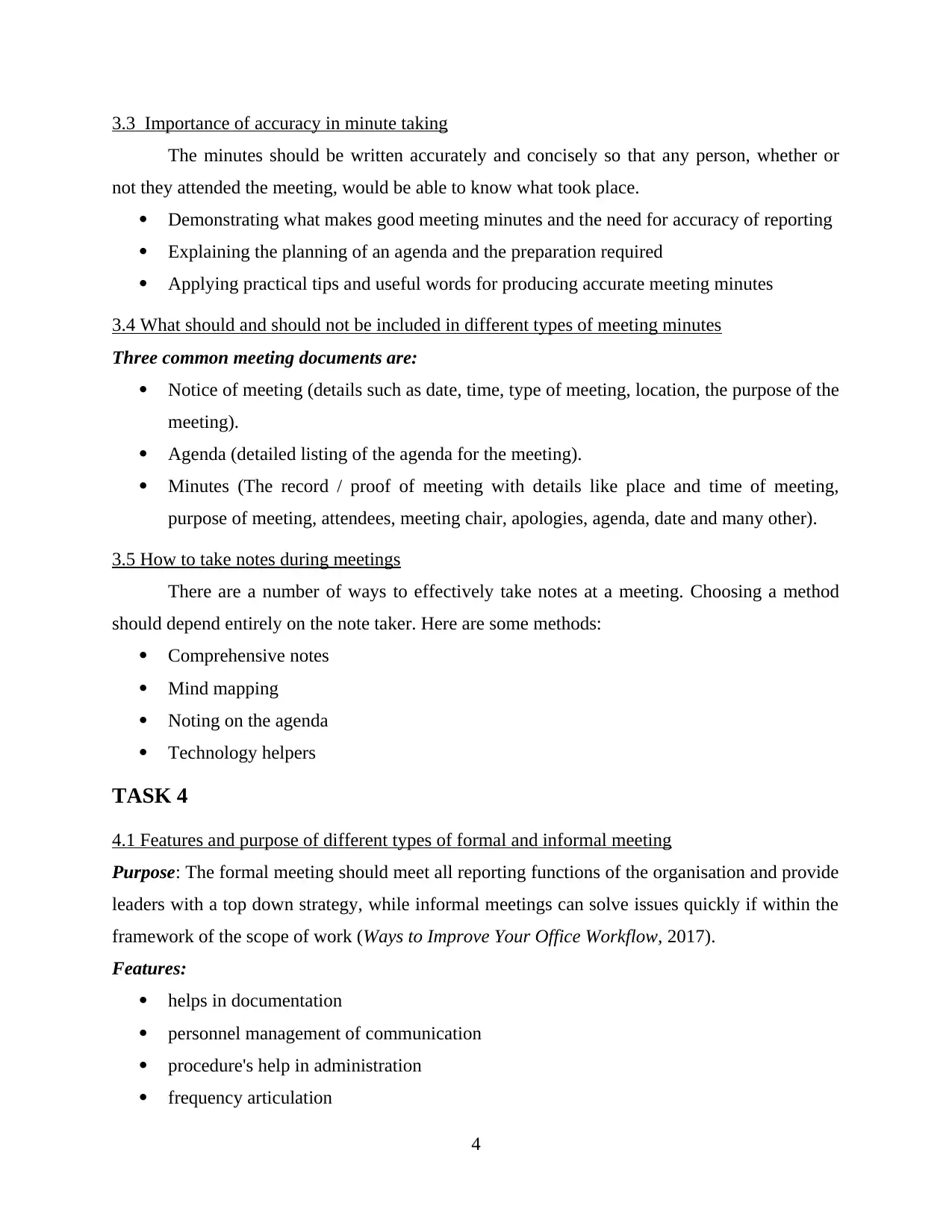
3.3 Importance of accuracy in minute taking
The minutes should be written accurately and concisely so that any person, whether or
not they attended the meeting, would be able to know what took place.
Demonstrating what makes good meeting minutes and the need for accuracy of reporting
Explaining the planning of an agenda and the preparation required
Applying practical tips and useful words for producing accurate meeting minutes
3.4 What should and should not be included in different types of meeting minutes
Three common meeting documents are:
Notice of meeting (details such as date, time, type of meeting, location, the purpose of the
meeting).
Agenda (detailed listing of the agenda for the meeting).
Minutes (The record / proof of meeting with details like place and time of meeting,
purpose of meeting, attendees, meeting chair, apologies, agenda, date and many other).
3.5 How to take notes during meetings
There are a number of ways to effectively take notes at a meeting. Choosing a method
should depend entirely on the note taker. Here are some methods:
Comprehensive notes
Mind mapping
Noting on the agenda
Technology helpers
TASK 4
4.1 Features and purpose of different types of formal and informal meeting
Purpose: The formal meeting should meet all reporting functions of the organisation and provide
leaders with a top down strategy, while informal meetings can solve issues quickly if within the
framework of the scope of work (Ways to Improve Your Office Workflow, 2017).
Features:
helps in documentation
personnel management of communication
procedure's help in administration
frequency articulation
4
The minutes should be written accurately and concisely so that any person, whether or
not they attended the meeting, would be able to know what took place.
Demonstrating what makes good meeting minutes and the need for accuracy of reporting
Explaining the planning of an agenda and the preparation required
Applying practical tips and useful words for producing accurate meeting minutes
3.4 What should and should not be included in different types of meeting minutes
Three common meeting documents are:
Notice of meeting (details such as date, time, type of meeting, location, the purpose of the
meeting).
Agenda (detailed listing of the agenda for the meeting).
Minutes (The record / proof of meeting with details like place and time of meeting,
purpose of meeting, attendees, meeting chair, apologies, agenda, date and many other).
3.5 How to take notes during meetings
There are a number of ways to effectively take notes at a meeting. Choosing a method
should depend entirely on the note taker. Here are some methods:
Comprehensive notes
Mind mapping
Noting on the agenda
Technology helpers
TASK 4
4.1 Features and purpose of different types of formal and informal meeting
Purpose: The formal meeting should meet all reporting functions of the organisation and provide
leaders with a top down strategy, while informal meetings can solve issues quickly if within the
framework of the scope of work (Ways to Improve Your Office Workflow, 2017).
Features:
helps in documentation
personnel management of communication
procedure's help in administration
frequency articulation
4
Paraphrase This Document
Need a fresh take? Get an instant paraphrase of this document with our AI Paraphraser
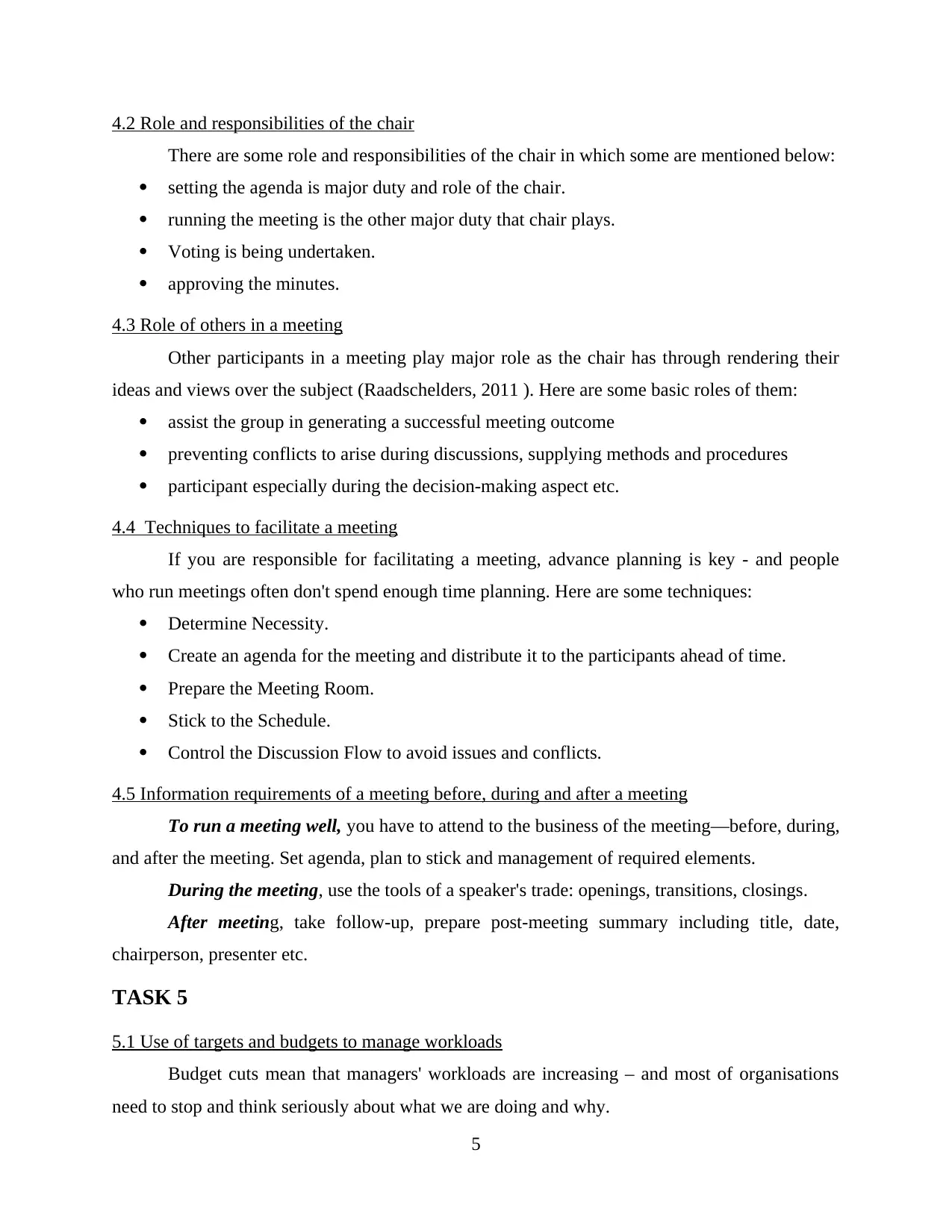
4.2 Role and responsibilities of the chair
There are some role and responsibilities of the chair in which some are mentioned below:
setting the agenda is major duty and role of the chair.
running the meeting is the other major duty that chair plays.
Voting is being undertaken.
approving the minutes.
4.3 Role of others in a meeting
Other participants in a meeting play major role as the chair has through rendering their
ideas and views over the subject (Raadschelders, 2011 ). Here are some basic roles of them:
assist the group in generating a successful meeting outcome
preventing conflicts to arise during discussions, supplying methods and procedures
participant especially during the decision-making aspect etc.
4.4 Techniques to facilitate a meeting
If you are responsible for facilitating a meeting, advance planning is key - and people
who run meetings often don't spend enough time planning. Here are some techniques:
Determine Necessity.
Create an agenda for the meeting and distribute it to the participants ahead of time.
Prepare the Meeting Room.
Stick to the Schedule.
Control the Discussion Flow to avoid issues and conflicts.
4.5 Information requirements of a meeting before, during and after a meeting
To run a meeting well, you have to attend to the business of the meeting—before, during,
and after the meeting. Set agenda, plan to stick and management of required elements.
During the meeting, use the tools of a speaker's trade: openings, transitions, closings.
After meeting, take follow-up, prepare post-meeting summary including title, date,
chairperson, presenter etc.
TASK 5
5.1 Use of targets and budgets to manage workloads
Budget cuts mean that managers' workloads are increasing – and most of organisations
need to stop and think seriously about what we are doing and why.
5
There are some role and responsibilities of the chair in which some are mentioned below:
setting the agenda is major duty and role of the chair.
running the meeting is the other major duty that chair plays.
Voting is being undertaken.
approving the minutes.
4.3 Role of others in a meeting
Other participants in a meeting play major role as the chair has through rendering their
ideas and views over the subject (Raadschelders, 2011 ). Here are some basic roles of them:
assist the group in generating a successful meeting outcome
preventing conflicts to arise during discussions, supplying methods and procedures
participant especially during the decision-making aspect etc.
4.4 Techniques to facilitate a meeting
If you are responsible for facilitating a meeting, advance planning is key - and people
who run meetings often don't spend enough time planning. Here are some techniques:
Determine Necessity.
Create an agenda for the meeting and distribute it to the participants ahead of time.
Prepare the Meeting Room.
Stick to the Schedule.
Control the Discussion Flow to avoid issues and conflicts.
4.5 Information requirements of a meeting before, during and after a meeting
To run a meeting well, you have to attend to the business of the meeting—before, during,
and after the meeting. Set agenda, plan to stick and management of required elements.
During the meeting, use the tools of a speaker's trade: openings, transitions, closings.
After meeting, take follow-up, prepare post-meeting summary including title, date,
chairperson, presenter etc.
TASK 5
5.1 Use of targets and budgets to manage workloads
Budget cuts mean that managers' workloads are increasing – and most of organisations
need to stop and think seriously about what we are doing and why.
5
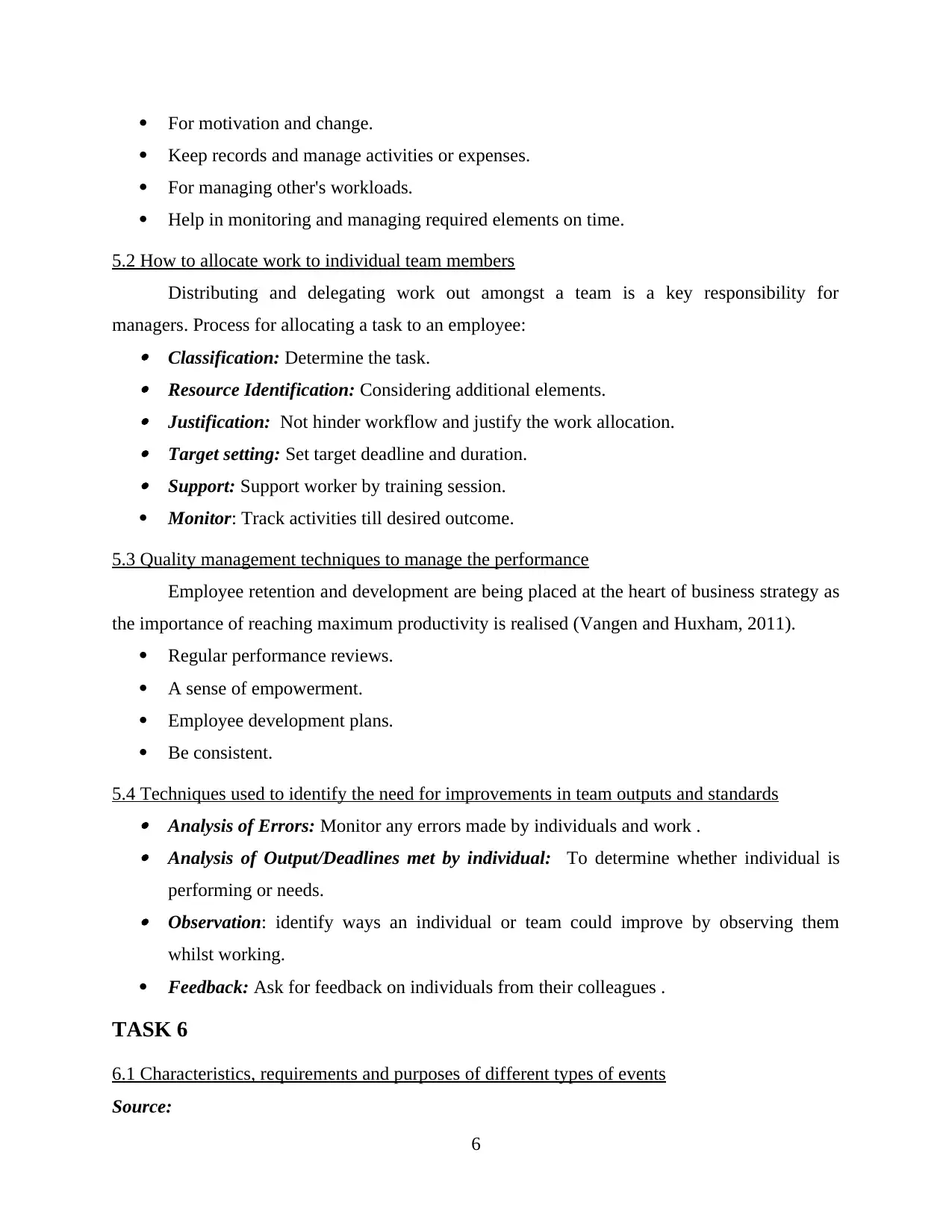
For motivation and change.
Keep records and manage activities or expenses.
For managing other's workloads.
Help in monitoring and managing required elements on time.
5.2 How to allocate work to individual team members
Distributing and delegating work out amongst a team is a key responsibility for
managers. Process for allocating a task to an employee: Classification: Determine the task. Resource Identification: Considering additional elements. Justification: Not hinder workflow and justify the work allocation. Target setting: Set target deadline and duration. Support: Support worker by training session.
Monitor: Track activities till desired outcome.
5.3 Quality management techniques to manage the performance
Employee retention and development are being placed at the heart of business strategy as
the importance of reaching maximum productivity is realised (Vangen and Huxham, 2011).
Regular performance reviews.
A sense of empowerment.
Employee development plans.
Be consistent.
5.4 Techniques used to identify the need for improvements in team outputs and standards Analysis of Errors: Monitor any errors made by individuals and work . Analysis of Output/Deadlines met by individual: To determine whether individual is
performing or needs. Observation: identify ways an individual or team could improve by observing them
whilst working.
Feedback: Ask for feedback on individuals from their colleagues .
TASK 6
6.1 Characteristics, requirements and purposes of different types of events
Source:
6
Keep records and manage activities or expenses.
For managing other's workloads.
Help in monitoring and managing required elements on time.
5.2 How to allocate work to individual team members
Distributing and delegating work out amongst a team is a key responsibility for
managers. Process for allocating a task to an employee: Classification: Determine the task. Resource Identification: Considering additional elements. Justification: Not hinder workflow and justify the work allocation. Target setting: Set target deadline and duration. Support: Support worker by training session.
Monitor: Track activities till desired outcome.
5.3 Quality management techniques to manage the performance
Employee retention and development are being placed at the heart of business strategy as
the importance of reaching maximum productivity is realised (Vangen and Huxham, 2011).
Regular performance reviews.
A sense of empowerment.
Employee development plans.
Be consistent.
5.4 Techniques used to identify the need for improvements in team outputs and standards Analysis of Errors: Monitor any errors made by individuals and work . Analysis of Output/Deadlines met by individual: To determine whether individual is
performing or needs. Observation: identify ways an individual or team could improve by observing them
whilst working.
Feedback: Ask for feedback on individuals from their colleagues .
TASK 6
6.1 Characteristics, requirements and purposes of different types of events
Source:
6
⊘ This is a preview!⊘
Do you want full access?
Subscribe today to unlock all pages.

Trusted by 1+ million students worldwide
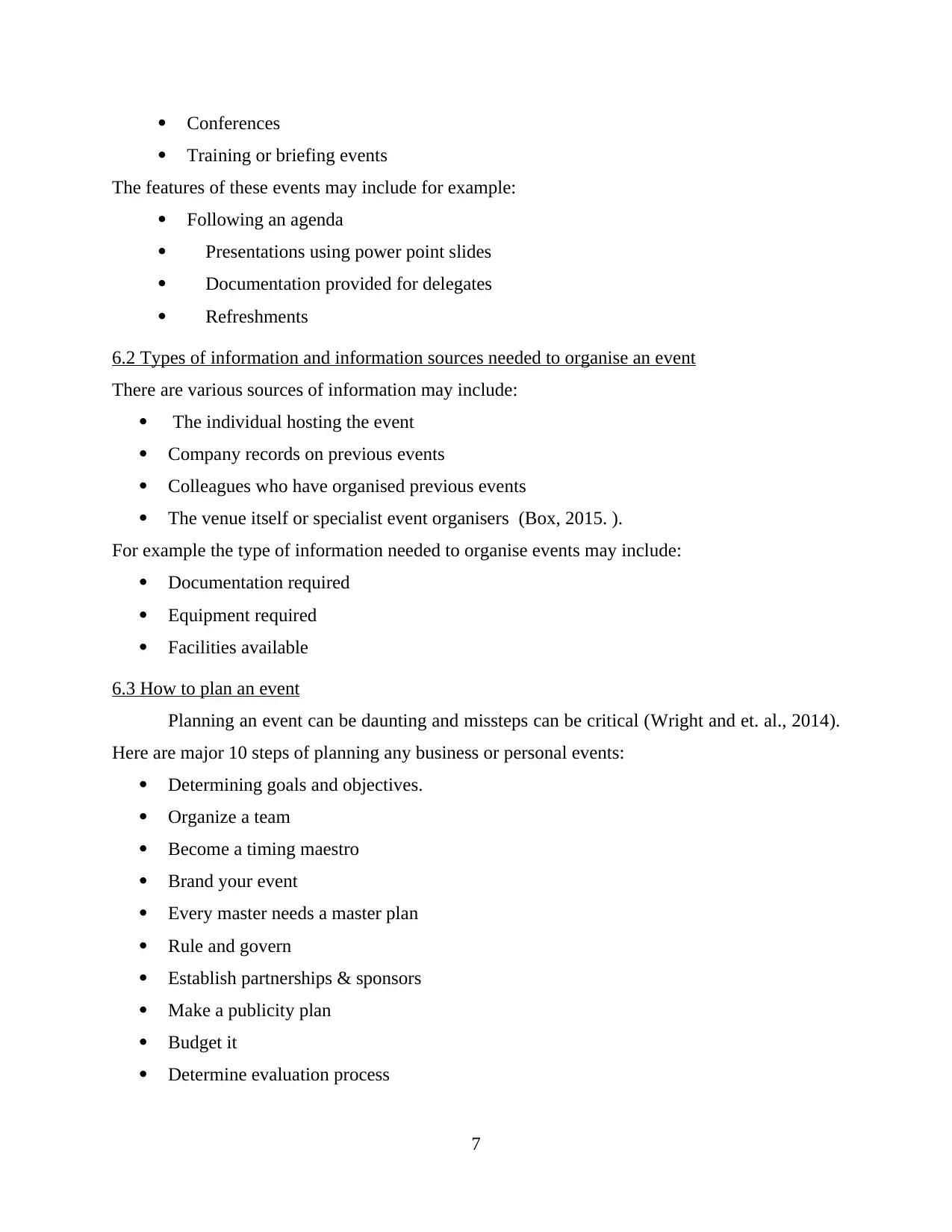
Conferences
Training or briefing events
The features of these events may include for example:
Following an agenda
Presentations using power point slides
Documentation provided for delegates
Refreshments
6.2 Types of information and information sources needed to organise an event
There are various sources of information may include:
The individual hosting the event
Company records on previous events
Colleagues who have organised previous events
The venue itself or specialist event organisers (Box, 2015. ).
For example the type of information needed to organise events may include:
Documentation required
Equipment required
Facilities available
6.3 How to plan an event
Planning an event can be daunting and missteps can be critical (Wright and et. al., 2014).
Here are major 10 steps of planning any business or personal events:
Determining goals and objectives.
Organize a team
Become a timing maestro
Brand your event
Every master needs a master plan
Rule and govern
Establish partnerships & sponsors
Make a publicity plan
Budget it
Determine evaluation process
7
Training or briefing events
The features of these events may include for example:
Following an agenda
Presentations using power point slides
Documentation provided for delegates
Refreshments
6.2 Types of information and information sources needed to organise an event
There are various sources of information may include:
The individual hosting the event
Company records on previous events
Colleagues who have organised previous events
The venue itself or specialist event organisers (Box, 2015. ).
For example the type of information needed to organise events may include:
Documentation required
Equipment required
Facilities available
6.3 How to plan an event
Planning an event can be daunting and missteps can be critical (Wright and et. al., 2014).
Here are major 10 steps of planning any business or personal events:
Determining goals and objectives.
Organize a team
Become a timing maestro
Brand your event
Every master needs a master plan
Rule and govern
Establish partnerships & sponsors
Make a publicity plan
Budget it
Determine evaluation process
7
Paraphrase This Document
Need a fresh take? Get an instant paraphrase of this document with our AI Paraphraser
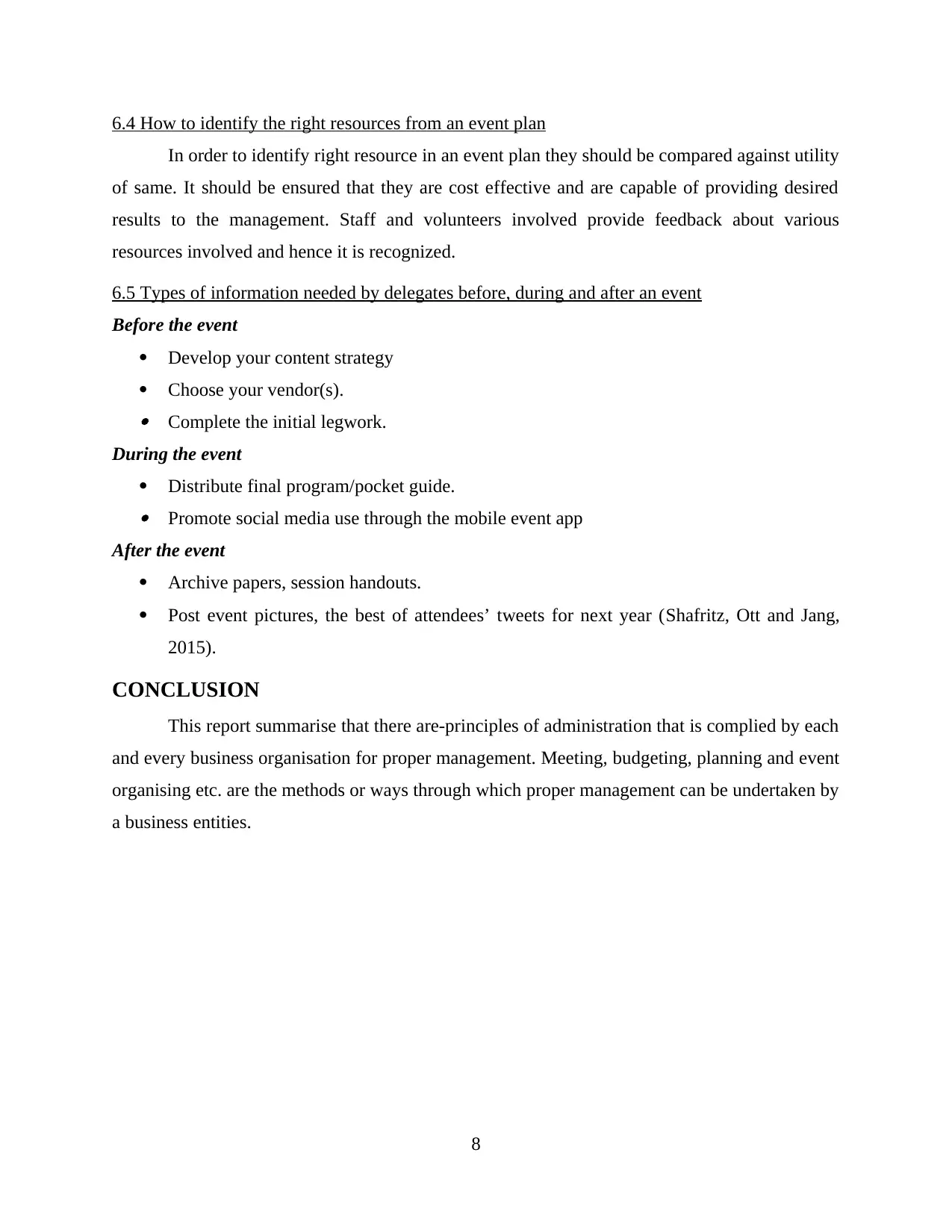
6.4 How to identify the right resources from an event plan
In order to identify right resource in an event plan they should be compared against utility
of same. It should be ensured that they are cost effective and are capable of providing desired
results to the management. Staff and volunteers involved provide feedback about various
resources involved and hence it is recognized.
6.5 Types of information needed by delegates before, during and after an event
Before the event
Develop your content strategy
Choose your vendor(s). Complete the initial legwork.
During the event
Distribute final program/pocket guide. Promote social media use through the mobile event app
After the event
Archive papers, session handouts.
Post event pictures, the best of attendees’ tweets for next year (Shafritz, Ott and Jang,
2015).
CONCLUSION
This report summarise that there are-principles of administration that is complied by each
and every business organisation for proper management. Meeting, budgeting, planning and event
organising etc. are the methods or ways through which proper management can be undertaken by
a business entities.
8
In order to identify right resource in an event plan they should be compared against utility
of same. It should be ensured that they are cost effective and are capable of providing desired
results to the management. Staff and volunteers involved provide feedback about various
resources involved and hence it is recognized.
6.5 Types of information needed by delegates before, during and after an event
Before the event
Develop your content strategy
Choose your vendor(s). Complete the initial legwork.
During the event
Distribute final program/pocket guide. Promote social media use through the mobile event app
After the event
Archive papers, session handouts.
Post event pictures, the best of attendees’ tweets for next year (Shafritz, Ott and Jang,
2015).
CONCLUSION
This report summarise that there are-principles of administration that is complied by each
and every business organisation for proper management. Meeting, budgeting, planning and event
organising etc. are the methods or ways through which proper management can be undertaken by
a business entities.
8
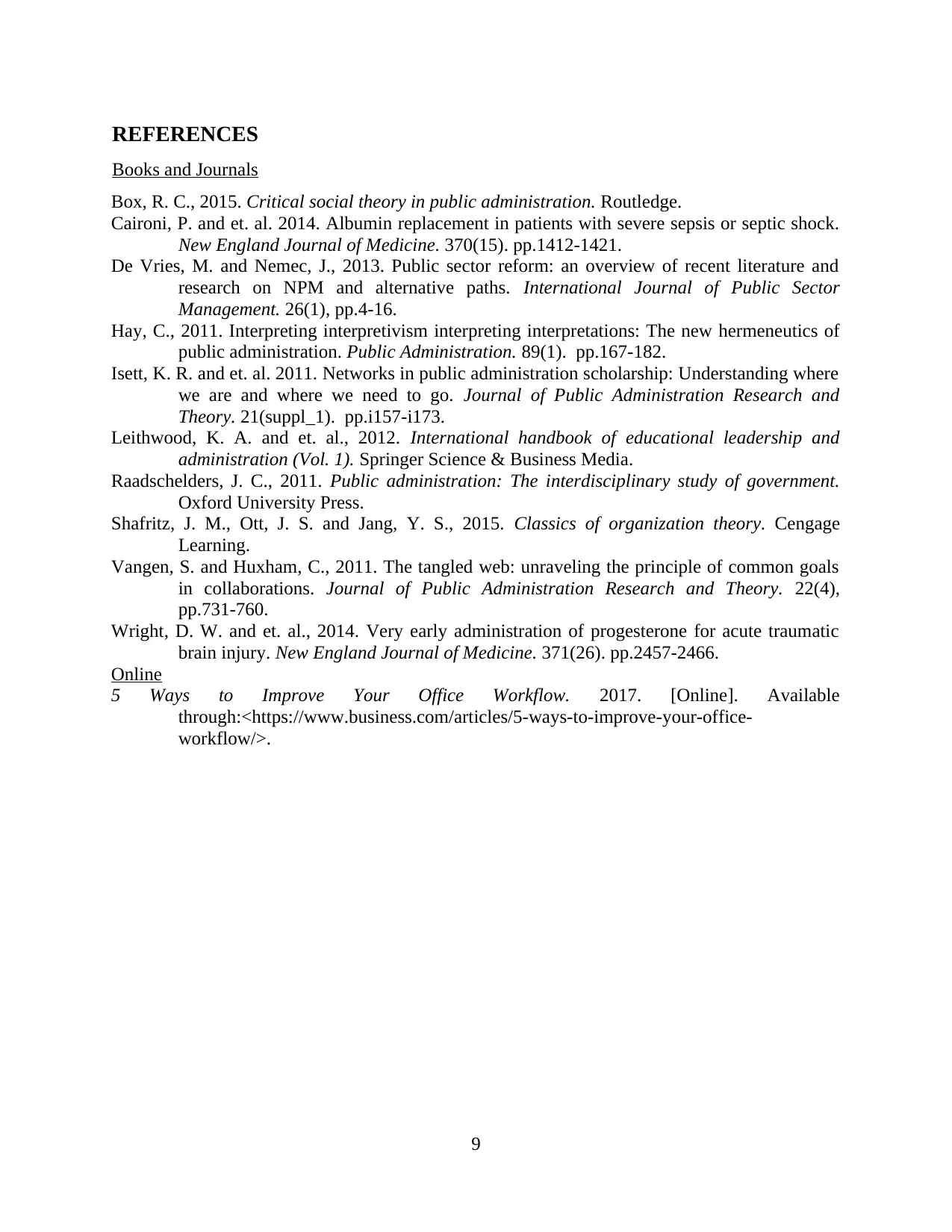
REFERENCES
Books and Journals
Box, R. C., 2015. Critical social theory in public administration. Routledge.
Caironi, P. and et. al. 2014. Albumin replacement in patients with severe sepsis or septic shock.
New England Journal of Medicine. 370(15). pp.1412-1421.
De Vries, M. and Nemec, J., 2013. Public sector reform: an overview of recent literature and
research on NPM and alternative paths. International Journal of Public Sector
Management. 26(1), pp.4-16.
Hay, C., 2011. Interpreting interpretivism interpreting interpretations: The new hermeneutics of
public administration. Public Administration. 89(1). pp.167-182.
Isett, K. R. and et. al. 2011. Networks in public administration scholarship: Understanding where
we are and where we need to go. Journal of Public Administration Research and
Theory. 21(suppl_1). pp.i157-i173.
Leithwood, K. A. and et. al., 2012. International handbook of educational leadership and
administration (Vol. 1). Springer Science & Business Media.
Raadschelders, J. C., 2011. Public administration: The interdisciplinary study of government.
Oxford University Press.
Shafritz, J. M., Ott, J. S. and Jang, Y. S., 2015. Classics of organization theory. Cengage
Learning.
Vangen, S. and Huxham, C., 2011. The tangled web: unraveling the principle of common goals
in collaborations. Journal of Public Administration Research and Theory. 22(4),
pp.731-760.
Wright, D. W. and et. al., 2014. Very early administration of progesterone for acute traumatic
brain injury. New England Journal of Medicine. 371(26). pp.2457-2466.
Online
5 Ways to Improve Your Office Workflow. 2017. [Online]. Available
through:<https://www.business.com/articles/5-ways-to-improve-your-office-
workflow/>.
9
Books and Journals
Box, R. C., 2015. Critical social theory in public administration. Routledge.
Caironi, P. and et. al. 2014. Albumin replacement in patients with severe sepsis or septic shock.
New England Journal of Medicine. 370(15). pp.1412-1421.
De Vries, M. and Nemec, J., 2013. Public sector reform: an overview of recent literature and
research on NPM and alternative paths. International Journal of Public Sector
Management. 26(1), pp.4-16.
Hay, C., 2011. Interpreting interpretivism interpreting interpretations: The new hermeneutics of
public administration. Public Administration. 89(1). pp.167-182.
Isett, K. R. and et. al. 2011. Networks in public administration scholarship: Understanding where
we are and where we need to go. Journal of Public Administration Research and
Theory. 21(suppl_1). pp.i157-i173.
Leithwood, K. A. and et. al., 2012. International handbook of educational leadership and
administration (Vol. 1). Springer Science & Business Media.
Raadschelders, J. C., 2011. Public administration: The interdisciplinary study of government.
Oxford University Press.
Shafritz, J. M., Ott, J. S. and Jang, Y. S., 2015. Classics of organization theory. Cengage
Learning.
Vangen, S. and Huxham, C., 2011. The tangled web: unraveling the principle of common goals
in collaborations. Journal of Public Administration Research and Theory. 22(4),
pp.731-760.
Wright, D. W. and et. al., 2014. Very early administration of progesterone for acute traumatic
brain injury. New England Journal of Medicine. 371(26). pp.2457-2466.
Online
5 Ways to Improve Your Office Workflow. 2017. [Online]. Available
through:<https://www.business.com/articles/5-ways-to-improve-your-office-
workflow/>.
9
⊘ This is a preview!⊘
Do you want full access?
Subscribe today to unlock all pages.

Trusted by 1+ million students worldwide
1 out of 12
Related Documents
Your All-in-One AI-Powered Toolkit for Academic Success.
+13062052269
info@desklib.com
Available 24*7 on WhatsApp / Email
![[object Object]](/_next/static/media/star-bottom.7253800d.svg)
Unlock your academic potential
Copyright © 2020–2025 A2Z Services. All Rights Reserved. Developed and managed by ZUCOL.





